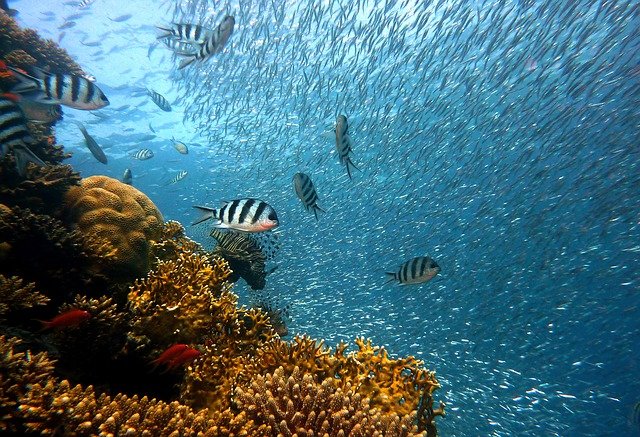Lifestyle
3 Myths About Deep Sea Catch-And-Release Fishing

When divers resurface too quickly from deep water, the intense change in pressure can make gasses dissolved in their blood bubble up. This problem can lead to nausea, fatigue, joint pain, and paralysis. In the worst cases, it can be fatal.
This is known as barotrauma, and it doesn’t only affect us. Dolphins, fish, and sea turtles can suffer severe injuries from sudden pressure changes.
When anglers pull fish from water 30 feet deep and more, their catch is susceptible to barotrauma. Coming rapidly to the surface can make the swim bladder in fish inflate or rupture. This can lead to the death of the fish.
If you’re deep-sea fishing and want to release a fish instead of eating it, you should know some myths about barotrauma:
#1: If The Fish Isn’t Bloated, There Is No Barotrauma
Bloating is indeed the most common sign in a fish you’ve caught. However, some fish – including sharks and cobia – lack swim bladders. They might not show bulging eyes or float on the surface after you release them, but they still could suffer from gasses in their tissues, just like people.
#2: A Fish That Swims Away Is Fine
Some anglers believe if a deepwater fish swims away with no apparent injuries that it doesn’t have barotrauma. Not necessarily.
Research indicates that barotrauma can have effects later that we don’t always see when we release the fish. A fish might swim away but still be injured. Then, it could get eaten by a predator as it swims back to the reef.
A barotrauma study on red snapper found that at least 15% of fish taken from deepwater died almost immediately. About 13% of fish were able to swim away but died within three days. So, nearly one out of three fish in the study did not survive catch and release.
Reef fish, particularly the oldest and biggest females that produce the most eggs per year, are too valuable to the ecosystem to be lost at that rate. It’s essential for anglers who catch and release to use release methods that provide fisher with a better chance of living another day. Even a small improvement in survival rates for these fish can mean millions more fish are saved every year.
#3: Venting Is The Only Way To Treat Barotrauma
Venting means puncturing the side of a fish’s body with a metal tool. When it is done right, venting can release the built-up gasses so they can escape from the bladder. This improves its ability to go back down deep and hopefully survive.
But venting comes with problems. First, it can be hard to vent the fish correctly. You need to have a decent knowledge of fish anatomy. If you poke it a few inches the wrong way, you could damage the fish’s internal organs. Also, you should not vent a fish when the stomach is sticking from the mouth or when the intestines come out of the anus. This can kill the fish.
Even if you vent the fish correctly, it still can suffer from the procedure, including a damaged swim bladder or infections.
Venting does improve the chance the fish will survive, but there are other options.
Try A Descending Device
A descending device returns the fish to deep water, where it can usually recover from barotrauma. You can use a descending device on any fish species, and you don’t even need to know fish anatomy! The more anglers that use descending devices, the more likely deepsea fish will thrive. And that is good for our planet.
Lifestyle
From Broken to Whole: The Radical Reawakening Behind The XI Code

Elle dela Cruz
Most healing begins with the assumption that something is broken. That the fix lies in the right therapist, diet, retreat, or ritual. Patchwork solutions for a fragmented self.
But for clients of The XI Code, the breakthrough did not come by fixing what was broken, it came by remembering what was never damaged to begin with.
It is not a spiritual placebo or self-help remix, rather a recalibration, a return, a radical stripping away of every distortion that ever claimed authority over who you are. Founded by Masati Sajady, The XI Code has become a sanctuary for those who sensed there had to be more and now live the proof of it.
This is not talking about polite gratitude or glow-up affirmations, these are accounts of full-system transformation, physical regeneration, identity coherence, and a kind of inner homecoming that makes every previous attempt feel like a rehearsal.
“This isn’t about self-help,” says Masati. “This is about self-realization. There is a version of you untouched by pain, trauma, or time and that is what XI reveals.”
Remembering the Self Beneath the Static
Those who enter the XI space often describe their experience not as something new they learned but as something ancient they finally remembered. One client shared: “I listened to Masati’s podcasts during a bottomless depression. I swear it pulled me from the dark to the light.”
But the words they use are not mystical or out of reach, rather grounded. “I feel safe in my body.” “I’ve come home.” “I finally see myself.”
This is not a performance of healing, it is a quiet, cellular knowing.
“I survived death and decoded life,” Masati explains. “I returned with the blueprint for those ready to rejuvenate the body, unlock peak performance, and evolve humanity.” Those words, radical to some, feel like a memory to others. As if, somewhere deep inside, they always knew this was possible.
When the Body Starts Listening
While XI is not a medical protocol, many clients describe physical transformations that coincide with their inner shift. One wrote: “I’ve begun rendering myself as my highest form, right here, in this space and time continuum.”
Another called it “the most effective healing method” they had found after years of traveling the world for answers. But the common thread was coherence. A recalibration across dimensions: physical, emotional, energetic, and ancestral. It is about resolving distortion at the origin point.
Rewriting the Lens of Reality
After engaging with The XI Code, many report not just feeling better but seeing life differently. Like a veil lifted. Like their perceptual field was reset.
One wrote: “My whole life is changing in every way and it’s just unfolding on its own. Every day, synchronicities. It’s like magic.”
Another put it simply: “I found my home and I wasn’t even looking.” Again and again, the word home appears in these testimonials not as a destination but as a state of being.
Masati explains this with precision: “XI doesn’t upgrade the version of you that’s broken. It reveals the YOU that was never broken to begin with.”
A Quiet, Powerful Community
Though The XI Code is not marketed as a group program, many clients describe a shared energetic field as being held by a collective intelligence moving through similar layers.
“I can’t wait to wake up and see how much more beautiful I’ve become,” one said not from ego but from evolution.
Because the work does not stop when the session ends. The system keeps unfolding, recalibrating, and upgrading.
Not for Everyone But For the Ready
Masati is unapologetic: “The XI journey requires the courage to see Truth on all levels, in all arenas, and to accept responsibility for the Life you’ve been gifted.”
It is not for those seeking a new story to believe in, rather for those ready to remove every distortion that ever told them they weren’t enough.
And what remains? The version of you before distortion and the one that was always whole.
You do not need to become someone new. You need to meet who you were before the noise.
-

 Tech4 years ago
Tech4 years agoEffuel Reviews (2021) – Effuel ECO OBD2 Saves Fuel, and Reduce Gas Cost? Effuel Customer Reviews
-

 Tech6 years ago
Tech6 years agoBosch Power Tools India Launches ‘Cordless Matlab Bosch’ Campaign to Demonstrate the Power of Cordless
-

 Lifestyle6 years ago
Lifestyle6 years agoCatholic Cases App brings Church’s Moral Teachings to Androids and iPhones
-

 Lifestyle4 years ago
Lifestyle4 years agoEast Side Hype x Billionaire Boys Club. Hottest New Streetwear Releases in Utah.
-

 Tech7 years ago
Tech7 years agoCloud Buyers & Investors to Profit in the Future
-

 Lifestyle5 years ago
Lifestyle5 years agoThe Midas of Cosmetic Dermatology: Dr. Simon Ourian
-

 Health6 years ago
Health6 years agoCBDistillery Review: Is it a scam?
-

 Entertainment6 years ago
Entertainment6 years agoAvengers Endgame now Available on 123Movies for Download & Streaming for Free
